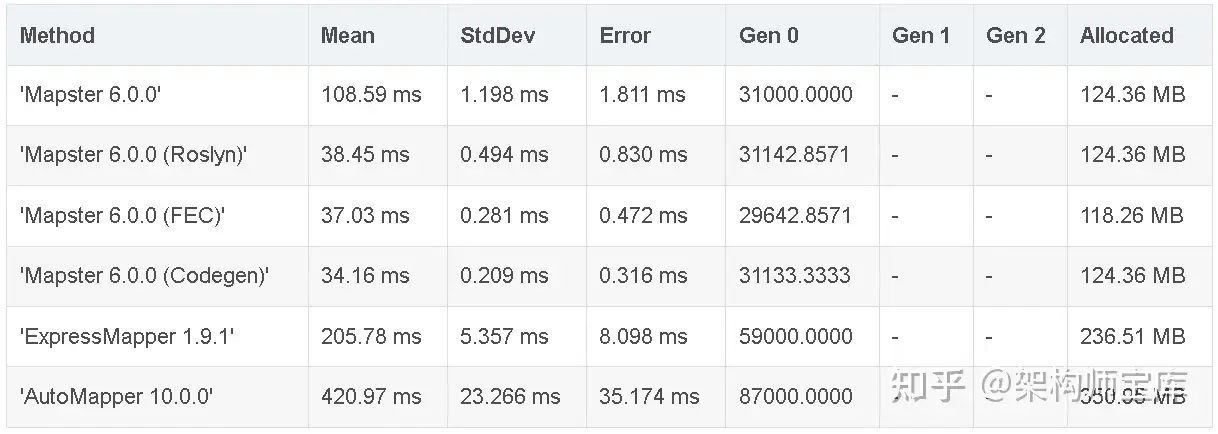NET领域性能最好的对象映射框架Mapster使用方法
Mapster是一个开源的.NET对象映射库,它提供了一种简单而强大的方式来处理对象之间的映射。在本文中,我将详细介绍如何在.NET中使用Mapster,并提供一些实例和源代码。
和其它框架性能对比:

Mapster的安装和配置:
- 首先,打开Visual Studio并创建一个新的.NET项目。
- 在NuGet包管理器控制台中运行以下命令来安装Mapster:Install-Package Mapster。
- 在项目中添加一个新的类文件,命名为MappingConfig.cs。这个类将用于配置Mapster的映射规则。
配置映射规则:
在MappingConfig.cs文件中,添加以下代码来配置映射规则:
using Mapster;
public static class MappingConfig
{
public static void Configure()
{
TypeAdapterConfig.GlobalSettings.Default.NameMatchingStrategy(NameMatchingStrategy.Flexible);
TypeAdapterConfig.GlobalSettings.Default.PreserveReference(true);
// 添加映射规则
TypeAdapterConfig<MySource, MyDestination>.NewConfig()
.Map(dest => dest.DestinationProperty, src => src.SourceProperty)
.Map(dest => dest.AnotherProperty, src => src.AnotherProperty);
}
}在上面的代码中,我们首先设置了Mapster的一些全局设置。
NameMatchingStrategy.Flexible表示属性名称不区分大小写。PreserveReference(true)表示保留引用关系。
然后,我们使用TypeAdapterConfig类的NewConfig方法来创建一个新的映射规则。在这个例子中,我们将MySource类映射到MyDestination类。使用Map方法来指定属性之间的映射关系。
使用Mapster进行对象映射:
在我们配置好映射规则后,我们可以在代码中使用Mapster来进行对象之间的映射。下面是一个简单的示例:
using Mapster;
public class MySource
{
public string SourceProperty { get; set; }
public string AnotherProperty { get; set; }
}
public class MyDestination
{
public string DestinationProperty { get; set; }
public string AnotherProperty { get; set; }
}
public class Program
{
static void Main(string[] args)
{
// 配置映射规则
MappingConfig.Configure();
// 创建源对象
var source = new MySource
{
SourceProperty = "Hello",
AnotherProperty = "World"
};
// 执行映射
var destination = source.Adapt<MyDestination>();
// 输出结果
Console.WriteLine(destination.DestinationProperty); // 输出:Hello
Console.WriteLine(destination.AnotherProperty); // 输出:World
}
}在上面的示例中,我们首先调用MappingConfig.Configure方法来配置映射规则。然后,我们创建了一个源对象source,并设置了它的属性值。接下来,我们使用Adapt方法将源对象映射到目标对象destination。最后,我们可以通过访问目标对象的属性来获取映射结果。
高级用法:
Mapster还提供了一些高级用法,用于处理更复杂的映射场景。
- 忽略属性映射:
有时候,我们可能希望在映射过程中忽略某些属性。可以使用Ignore方法来实现:
TypeAdapterConfig<MySource, MyDestination>.NewConfig()
.Ignore(dest => dest.DestinationProperty);- 自定义属性映射:
可以使用MapWith方法来自定义属性之间的映射逻辑:
TypeAdapterConfig<MySource, MyDestination>.NewConfig()
.Map(dest => dest.DestinationProperty, src => src.SourceProperty.ToUpper());- 集合映射:
Mapster还支持集合之间的映射。例如,我们有一个包含多个MySource对象的列表,我们可以使用Adapt方法将它们映射到包含多个MyDestination对象的列表:
var sourceList = new List<MySource>
{
new MySource { SourceProperty = "Hello", AnotherProperty = "World" },
new MySource { SourceProperty = "Foo", AnotherProperty = "Bar" }
};
var destinationList = sourceList.Adapt<List<MyDestination>>();- 嵌套对象映射:
如果源对象和目标对象中包含嵌套的对象,我们可以使用MapWith方法来处理嵌套对象的映射:
TypeAdapterConfig<MySource, MyDestination>.NewConfig()
.Map(dest => dest.NestedObject, src => src.NestedObject.Adapt<NestedDestination>());以上就是使用Mapster进行对象映射的方法、步骤和一些高级用法的介绍。通过使用Mapster,我们可以轻松地处理对象之间的映射,并且可以根据需要进行自定义和扩展。





【推荐】国内首个AI IDE,深度理解中文开发场景,立即下载体验Trae
【推荐】编程新体验,更懂你的AI,立即体验豆包MarsCode编程助手
【推荐】抖音旗下AI助手豆包,你的智能百科全书,全免费不限次数
【推荐】轻量又高性能的 SSH 工具 IShell:AI 加持,快人一步
· DeepSeek 开源周回顾「GitHub 热点速览」
· 物流快递公司核心技术能力-地址解析分单基础技术分享
· .NET 10首个预览版发布:重大改进与新特性概览!
· AI与.NET技术实操系列(二):开始使用ML.NET
· 单线程的Redis速度为什么快?
2017-04-07 微信开发——带参数二维码的使用
2016-04-07 C# 使用正则表达式去掉字符串中的数字,或者去掉字符串中的非数字
2016-04-07 JS中数组的操作
2015-04-07 asp.net mvc ChildActionOnly 和ActionName的用法